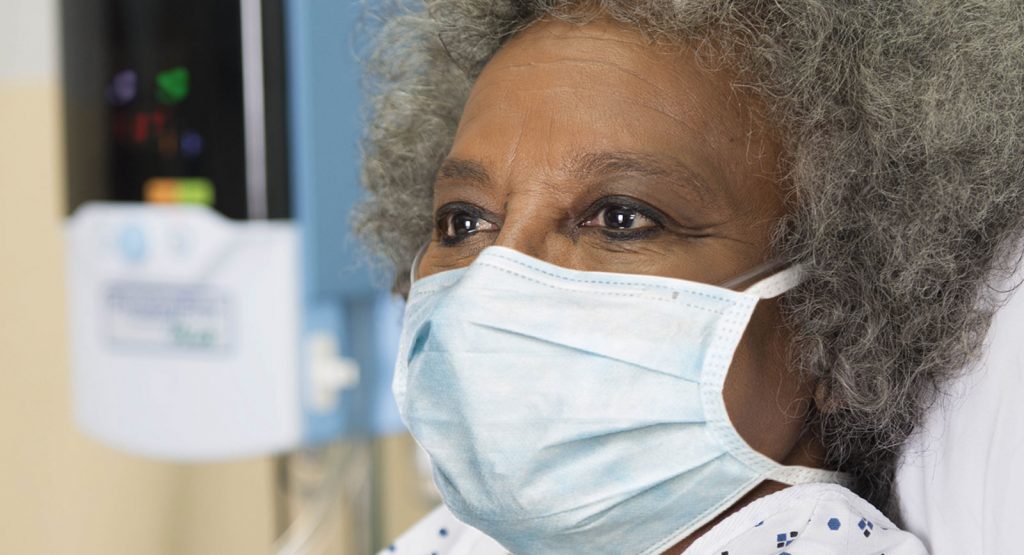COPD Patients and COVID-19 – Understanding the Scope of High Velocity Therapy

We’ve known that people with underlying conditions are at greater risk for worse COVID-19 outcomes. Thanks to the research of Leung and colleagues, we now better understand some of the mechanisms that may be exacerbating the outcomes for smokers and COPDers who contract COVID-19.
In their recently published article, “ACE-2 Expression in the Small Airway Epithelia of Smokers and COPD Patients: Implications for COVID-19”, the researchers conclude that smokers and COPD patients have greater quantities of a cell receptor— Angiotensin-converting enzyme (ACE)-2—in their lower airway tract. [1] This has significant implications because this specific receptor is the entryway through which the SARS-CoV-2 virus—which causes COVID-19—enters and infects the cell.
The combination of COVID-19 on top of COPD presents several management challenges. Traditionally, a COPD patient in respiratory distress would have been treated with Noninvasive Positive Pressure Ventilation (NiPPV) to address hypercapnia. NiPPV is one of the tools suggested for COVID-19 respiratory management in several guidelines across the world, but it is not uniformly recommended. Some organizations, like the Society for Critical Care Medicine (SCCM) [2] and the Australian and New Zealand Intensive Care Society (ANZICS) [3] suggest trial of high flow nasal oxygen on patients not requiring intubation and use of NiPPV only if high flow therapy is unavailable or failed.
In their letter “High flow nasal cannula is a good treatment option for COVID-19”, Geng and colleagues further point out that NiPPV “requires man-machine cooperation and is uncomfortable.” [4]
Using Vapotherm High Velocity Therapy to Address Hypercapnia
With certain guidelines and practitioners expressing a preference for high flow in COVID-19 patients, it’s important for clinicians to understand that not all high flow is the same. High velocity therapy may at first glance look similar to high flow—it’s a device that delivers high liter flows of conditioned gas through a nasal cannula. However, high velocity therapy is a form of mask-free NIV that offers ventilatory support for patients in respiratory distress, including hypercapnia, hypoxemia, dyspnea, and respiratory distress secondary to other medical conditions. It has the clinical efficacy of NiPPV, but without the mask. [5] Because of this, it may be an attractive tool for clinicians managing COVID-19 patients with COPD who don’t need to be intubated.
One of the reasons ANZICS doesn’t recommend NiPPV for routine use is because the transmission risk, especially with a poor mask fit, may be higher than in high flow devices. [3] High velocity therapy also offers an advantage here because similar to HFNC, it has a nasal cannula interface. Computer modeling suggests that use of a surgical mask over high velocity therapy may reduce the risk of particle dispersion and therewith the potential for clinicians to come into contact with infected particles.
Understanding the scope of high velocity therapy could greatly improve options for clinicians managing COVID-19 patients, especially if they may present with hypercapnia as well.
Visit our COVID-19 Resource Center for up-to-date answers to additional frequently asked questions.
REFERENCES
[1] Leung, Janice M. et al. ACE-2 Expression in the Small Airway Epithelia of Smokers and COPD Patients: Implications for COVID-19. European Respiratory Journal 2020. DOI: 10.1183/13993003.00688-2020
[2] Alhazzani W, Moller MH, Arabi YM, et al. Surviving Sepsis Campaign: Guidelines on the Management of Critically Ill Adults with Coronavirus Disease 2019 (COVID-19). Critical care medicine. 2020;PREPUBLICATION.
[3] The Australian and New Zealand Intensive Care Society (ANZICS). COVID-19 Guidelines. Version 1. 16 March 2020. https://www.anzics.com.au/wp-content/uploads/2020/03/ANZICS-COVID-19-Guidelines-Version-1.pdf
[4] Geng, Shike et al. High flow nasal cannula is a good treatment option for COVID-19. Heart & Lung: The Journal of Cardiopulmonary and Acute Care. April 13, 2020. DOI:https://doi.org/10.1016/j.hrtlng.2020.03.018
[5] Doshi, Pratik et al. High-Velocity Nasal Insufflation in the Treatment of Respiratory Failure: A Randomized Clinical Trial. Annals of Emergency Medicine, 2018. Published online ahead of print. https://www.ncbi.nlm.nih.gov/pubmed/29310868